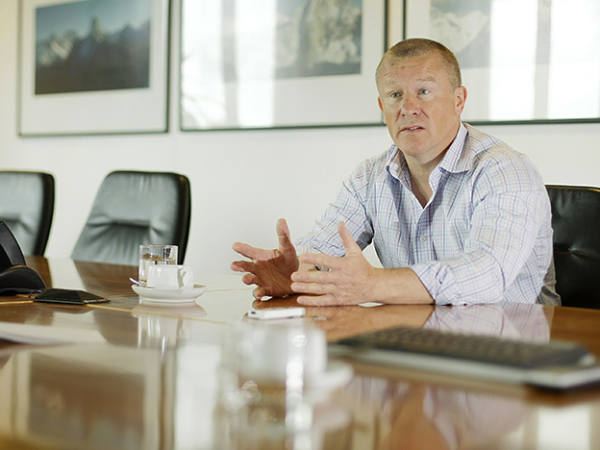The last two letters in 'Bric', the acronym coined in 2001 by Goldman Sachs chairman Jim O'Neill to represent economies at a similar stage of newly advanced development, stand for India and China. But, as important as the two Asian giants are, they are not everything that Asia and emerging markets have to offer. In Asia alone, there are many markets in the region with good investment fundamentals - and in some cases potentially more growth than India or China as they are less developed (you can read last week's article on India here).
Asian governments are generally solvent and their financial sectors remain strong, while these economies are growing fast and their populations are young. This is boosted by a growing middle class, which is increasing consumer spending. Companies are in good shape and have scope to grow their earnings over the longer term, and Asia is one of the highest-yielding regions globally (see Asia leads the world for income).
IC Top 100 Fund Aberdeen Asian Income (AAIF) reports in its recent annual report that its "heavy exposure to south-east Asia, in particular the holdings in Thailand, Malaysia and Singapore, and consumer-related sectors contributed significantly to returns".
Aberdeen also says that Association of Southeast Asian Nations (ASEAN) markets - Indonesia, Malaysia, the Philippines, Singapore and Thailand - were resilient in 2012 and, more recently, Indonesia, Malaysia, Thailand and the Philippines have been supported by healthy domestic consumption and government infrastructure spending.
The World Bank estimates, for example, that the Thai economy will grow by 5 per cent this year, even as it slashed its global growth forecast to an uninspiring 2.4 per cent. Consumer-focused companies such as Siam Makro, the country's largest cash-and-carry wholesaler, have done well, benefiting greatly from Thailand's growing consumer sector.
Key performance contributors for Aberdeen Asian Smaller Companies Investment Trust (AAS), also an IC Top 100 Fund, include property and insurance companies, and banks. Examples include Thai consumer finance company Aeon Thana Sinsap and Indonesian bank OCBC Nisp. Aeon Thana's "growth should be underpinned by firm domestic demand and the expansion of its business in neighbouring countries such as Laos and Vietnam. Its asset quality remains stable as the bank is prudently managed and maintains high standards of credit control," reports the trust.
Other companies that helped performance included Malaysian cement manufacturer Tasek Corp, which was buoyed by a raft of government infrastructure projects.
Mike Kerley, manager of Henderson Far East Income investment trust (HFEL), argues that there is a structural uptrend across ASEAN markets with earnings only where they were around 2007, following problems such as the floods in 2011. Thailand could also be buoyed by the strength of Japan, if recent economic reforms are successful, because many Japanese companies manufacture in Thailand.
Valuation and risk
Valuations are not the most promising, however, with MSCI Asia Pacific ex Japan trading on a price/earnings ratio of around 13.4 times. Individual markets such as Thailand are trading as high as around 18 times earnings.
"The south-east Asian markets have been the main focus for investors in Asia over the past year," says Gary Dugan, chief investment officer for Asia and the Middle East at private bank Coutts. "The Philippines, Thailand and Indonesia have seen very heavy inflows of foreign capital into both bond and equity markets. South-east Asian markets are in our view somewhat overvalued at current levels. The only market we remain positive about is Malaysia where we see a reacceleration of growth and increasing investor interest after the pending general elections. We prefer Korea and Taiwan, which we believe to be cheap and overdiscounting recent bad news."
However, despite a rise in valuations, Asian equities still offer opportunities for buy-and-hold investors, argues Aberdeen Asset Management, and while markets such as Thailand are no longer a bargain, it remains poised for long-term structural growth, given its pro-business government and healthy corporate fundamentals.
Investing in Asia includes exposure to emerging markets, which tend to be more volatile and less liquid than developed markets. You also tend to get lower corporate governance than those in developed economies. However, Darius McDermott, managing director at Chelsea Financial Services, says: "If you are investing for the long term, I think the positives outweigh these negatives, especially if you invest in a fund with a well-resourced team trying to avoid problem companies for you."
While Asia has better fundamentals than western economies, it is not immune from global economic problems, so the uncertain outlook for the global economy could be detrimental. More international economies such as South Korea, Singapore and Taiwan can suffer from lower exports if there is a decline in global trade. Countries in these regions are also vulnerable to the economic health of China.
While abundant liquidity from the ultra-loose monetary policy in the developed world has been supportive of Asian equities, this has created unintended consequences for the region's asset prices. Strong capital inflows from foreign investors seeking yields could result in damaging asset price bubbles and have already prompted some governments to tighten measures in property and other asset classes to moderate the influx. Historically, low interest rates have also stoked inflationary fears in some economies, while the territorial dispute between China and Japan, tensions between North and South Korea, and an election in Malaysia this year add political uncertainty.
But the International Monetary Fund (IMF) expects developing Asia to lead the 3.5 per cent growth in the global economy this year, due to the region's healthier fiscal, corporate and economic fundamentals versus the west. The growing importance of domestic demand as a growth driver may help buffer the impact of subdued consumption in the US and Europe, although structural shifts will take some time to achieve.
Best Asian funds
Single-country funds are high-risk because of their focus on one area, so can be more volatile, and in emerging markets these risks are heightened. "We would not normally recommend that investors use single-country funds in small markets," says Mr Dugan. "It is better that investors use a broad multi-country product that covers the whole of the pacific rim. The smaller markets are very illiquid and can be very volatile. As much as you can make 50 per cent in a straight line you can also see a 50 per cent fall in a short order of time."
In any case, for UK private investors there are few choices in terms of single-country funds. Those available include Aberdeen New Thai Investment Trust (ANW), which has beaten its benchmark, Stock Exchange of Thailand Index, over one, three and five years.
There are also a number of exchange traded funds (ETFs), including HSBC MSCI Indonesia (HIDR), MSCI Malaysia (HMYR) and MSCI Taiwan (HTWN), which buy shares in the indices they track and have a low charge of 0.6 per cent.
db X-trackers offers its FTSE Vietnam UCITS ETF (XFVT), which gets its returns via a derivative swap rather than buying the shares and charges 0.85 per cent. db X-trackers MSCI Thailand Index UCITS ETF (XCS4) also uses synthetic replication and has a charge of 0.5 per cent.
A broader Asian fund is probably a better option as it gives you exposure to a number of these markets, spreading the risk, and exposure to more opportunity. Options include IC Top 100 Fund First State Asia Pacific Leaders (GB0033874214), which includes overweight exposure to Singapore and Malaysia relative to its index, and is among the top 25 per cent of performers in the Asia ex Japan fund sector over one, three and five years.
Mr McDermott suggests Aberdeen Asia Pacific (GB00B0XWNF82) and Schroder Asian Alpha Plus (GB00B284G093). Aberdeen Asia Pacific has beaten MSCI AC Asia Pacific ex Japan over one, three and five years, and is among the top 25 per cent of performers in the Asia ex Japan fund sector over three and five years.
Schroder Asian Alpha Plus is among the top-performing Asian ex Japan funds over three and five years, but has not done so well over one. But it beats MSCI AC Far East ex Japan over one, three and five years.
Asian funds
| Fund | 1-year cumulative total return (%) | 3-year cumulative total return (%) | 5-year cumulative total return (%) | Total expense ratio (%) |
|---|---|---|---|---|
| Aberdeen Asia Pacific A Acc | 12.36 | 26.34 | 68.87 | 1.84 |
| Baring ASEAN Frontiers A EUR Inc | 24.78 | 52.64 | NA | 1.75 |
| First State Asia Pacific A | 17.73 | 36.11 | 77.44 | 1.83 |
| Schroder Asian Alpha Plus A Acc | 11.29 | 35.98 | 90.25 | 1.71 |
| MSCI AC ASIA PACIFIC ex JAPAN GDP GR USD | 8.83 | 8.33 | 40.22 | |
| MSCI South East Asia GR USD | 18.46 | 48.28 | 105.79 |
Source: Morningstar. Performance data as at 5 April 2013
Among investment trusts, some of the strongest performers include Aberdeen New Dawn (ABD) and Edinburgh Dragon (EFM), which have beaten their peer average and the MSCI AC Asia Pacific ex Japan index over one, three and five years. Both are on significant discounts to their underlying net asset value.
Asian investment trusts
Investment trust | 1-year cumulative share price total return (%) | 3-year cumulative share price total return (%) | 5-year cumulative share price total return (%) | Discount/premium to NAV (%) | Ongoing charge (%) |
|---|---|---|---|---|---|
Aberdeen Asian Income | 28.76 | 72.44 | 127.83 | +3.59 | 1.38 |
Aberdeen Asian Smaller | 39.80 | 111.64 | 208.80 | +4.04 | 1.51 |
Aberdeen New Dawn | 16.04 | 34.34 | 81.13 | -9.66 | 1.05 |
Aberdeen New Thai | 52.23 | 151.89 | 219.94 | -4.76 | 1.55 |
Edinburgh Dragon | 14.12 | 36.59 | 86.55 | -6.53 | 1.27 |
Henderson Far East Income | 23.49 | 31.82 | 61.63 | +0.99 | 1.21 |
MSCI AC ASIA PACIFIC ex JAPAN GDP NR USD | 8.54 | 7.54 | 38.42 | ||
Stock Exchange of Thailand 100 TR THB | 37.21 | 121.08 | 195.88 |
Source: Morningstar. Performance data as at as at 5 April 2013
A more focused option is the Baring ASEAN Frontiers Fund (IE00B3BC5T90). "We like the Baring ASEAN fund for those wanting access to non-standard Asian markets," says Mr McDermott. "Barings is a specialist in the emerging and Asian markets and the performance of the fund has been strong since its launch. We like the look of the ASEAN markets longer term: it's an interesting area with a lot of growth possibilities and gives investors access to some markets either not covered or not covered to a large extent by more generalist Asian equity funds."
Read our interview with the manager of Baring ASEAN Fund
Overall, Asia and emerging markets could account for up to 5 per cent of a cautious investor's portfolio, 10 per cent for a medium-risk investor and 25 per cent for a higher-risk investor, according to Gavin Haynes, managing director of Whitechurch Securities.












